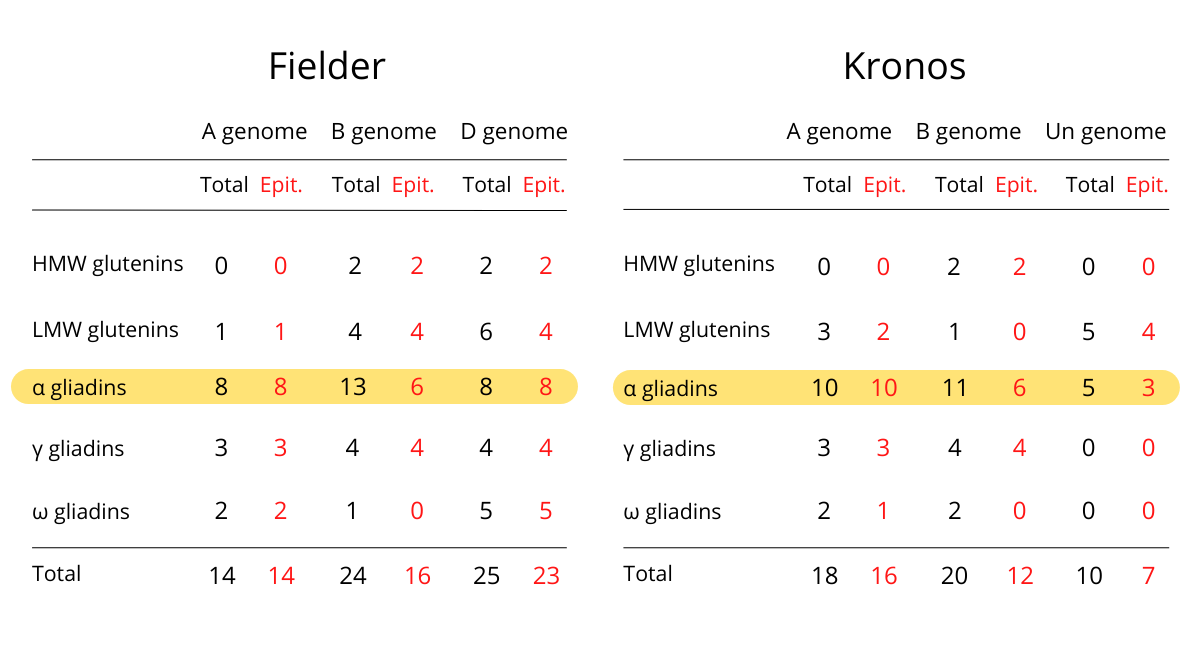On August 1, 2021, the Celiac Disease Foundation awarded a research grant to a project at the Dubcovsky Lab at the University of California, Davis to help fund the development of commercially viable celiac disease-safe wheat varieties for bread and pasta. Dr. Jorge Dubcovsky and Dr. Wenjun Zhang submitted to the Foundation the grant’s first six-month report that details a number of promising advances toward the project goal. We want to share with you highlights from the report and thank you, again, for your generous support of the Foundation, which funds exciting research initiatives like these.
The report reiterates the specific path they are taking to produce celiac-safe wheat:
One of the objectives of our project is to generate one pasta (tetraploid variety Kronos) and bread wheat (hexaploid variety Fielder) line without any CeD [celiac disease] epitopes. A necessary first step to achieve this objective is the development of a complete catalogue of the gluten proteins containing epitopes present in these two varieties. We collaborated with the Earlham Institute to generate a first draft of the Kronos genome and the Fielder genome to become available at the end of 2021 {Sato, 2021 #5926}. We used bioinformatics approaches to identify all the high molecular weight (HMW) glutenins, low molecular weight (LMW) glutenins, and α, γ and ω gliadin proteins present in these varieties. We then investigated the presence of CeD epitopes in each of these proteins using the comprehensive lists published by Sollid and Juhasz {Sollid, 2012 #4754; Sollid, 2020 #5927; Juhasz, 2018 #5353}. The results from this work are summarized in Table 1 below.
Table 1. Numbers in black on the left indicate the total number of proteins encoded in each locus, and numbers in red indicate the number of proteins with CeD epitopes.
An interesting observation from this study is that the alpha gliadins [highlighted in yellow] are the class with the highest number of epitopes, representing 54.3% of the CeD epitopes in Kronos and 41.5% of the epitopes in Fielder. These results indicate that the elimination of the alpha gliadins alone can reduce the level of CeD epitopes in wheat to half, and that their elimination should be an important first step in our objective to develop reduced allergenicity wheat.
In addition to these critical findings, the team at UC Davis has reached out to other public research programs to explore collaborations that can accelerate the process, including testing the allergenicity of our wheat breeds against intestinal organoids, as well as support to breed chemically-induced genetic variations. Already, one of the crossbred wheats has been planted in the field to evaluate grain yield and bread-making quality. The results have been encouraging!
We are excited about the progress being made to produce a celiac-safe wheat. We do recognize that there remains a lot of research to be done and that we are, if successful, years away from producing one or more commercially viable wheat strains that are safe for celiac patients. But we are committed to investing in research that may improve the quality of life for the celiac patient community.
We are able to fund groundbreaking research at leading universities and hospitals like UC Davis, USC, Stanford University, Children’s National, Boston Children’s Hospital, University of Colorado, UChicago, and Columbia University because of the generous financial support we receive from our community. We have more compelling projects in the research pipeline that we are seeking to fund.
If you would like to learn more about how you can help, please let me know. And if you have additional questions about the celiac-safe wheat research covered in this report, please contact me at marilyn.geller@celiac.org.
To Our Health,
Marilyn G. Geller
Chief Executive